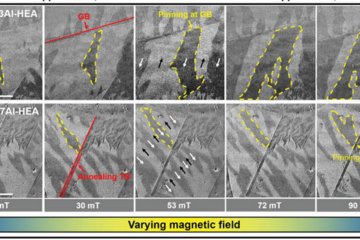All genres
1681.
Talk
Microscopic behavior of dense red blood cell suspensions in shear flow: A hybrid lattice Boltzmann finite element simulation study. Discrete Simulation of Fluid Dynamics 2011, Fargo, ND, USA (2011)
1682.
Talk
Understanding TWIP steel microstructures by using advanced electron microscopy and ab initio predictions. International Conference on Processing & Manufacturing of Advanced Materials THERMEC 2011, Québec City, QC, Canada (2011)
1683.
Talk
The influence of planar slip and deformation twinning on mechanical behavior in TWIP steels. International Conference on Processing & Manufacturing of Advanced Materials THERMEC 2011, Québec City, QC, Canada (2011)
1684.
Talk
Experiments and Modeling on the development of deformation textures in f.c.c. materials. International Conference on Processing & Manufacturing of Advanced Materials, THERMEC 2011, Québec City, QC, Canada (2011)
1685.
Talk
Explosive cladding of Titanium to low carbon steel: Microstructure and Properties. THERMEC 2011, Québec City, QC, Canada (2011)
1686.
Talk
Numerical Simulation of Dynamic Strain-induced austenite-ferrite transformation and post-dynamic kinetics in a low carbon steel. THERMEC 2011, 7th international conference on processing and manufacturing of advanced materials, Québec City, QC, Canada (2011)
1687.
Talk
Design principles of crustacean cuticle: From molecules to skeletal elements. Workshop „From Nanoparticle Assembly to Functional Polymer Components” at Department of Geo- and Environmental Sciences, LMU, München, Germany (2011)
1688.
Talk
A modular crystal plasticity framework applicable from component to single grain scale. THERMEC 2011, Québec City, QC, Canada (2011)
1689.
Talk
Particle-resolved simulation of blood in simple shear flow: Shear-thinning behavior and its microscopic origin(s). Institut für Festkörperforschung, FZ Jülich, Jülich, Germany (2011)
1690.
Talk
Characterization of CI(G)S thin-film solar cells using atom probe tomography. 37th IEEE Photovoltaic Specialists Conference (PVSC), Seattle, WA, USA (2011)
1691.
Talk
Effect of strain path and texture on microstructure in Fe–22 wt.% Mn–0.6 wt.% C TWIP steel. 1st International Conference on High Manganese Steels 2011, Seoul, South Korea (2011)
1692.
Talk
A dislocation density-based constitutive model for TWIP steels. 1st International Conference on High Manganese Steels, Seoul, South Korea (2011)
1693.
Talk
Structure and function of the biological photonic crystals in the scales of a beetle. European Materials Research Society E-MRS Spring Meeting 2011, May 2011, Nice, France (2011)
1694.
Talk
Study of iron EAM potentials and their effects on dislocation dynamic. E-MRS Spring Meeting, Nice, France (2011)
1695.
Talk
Alloy design of nanoprecipitate-hardened high-Mn maraging-TRIP and -TWIP steels. 1st International Conference on High Manganese Steels 2011, Seoul, South Korea (2011)
1696.
Talk
Atomistic understanding of hundred-thousand tons. Bernkastel-Kues Workshop on Possibilities and Limitations of Quantitative Materials Modeling and Characterization, Bernkastel-Kues, Germany (2011)
1697.
Talk
Designing structural metallic materials by combining ab-initio models, atomic scale characterization, and synthesis. Colloquium Lecture, Physics Department University Mainz, Mainz, Germany (2011)
1698.
Talk
Computational Crystal Plasticity. Korea Institute of Science and Technology (KIST), Seoul, South Korea (2011)
1699.
Talk
Deformation induced dislocation interactions near martensite-ferrite phase boundaries. MRS Fall Meeting 2011, San Francisco, CA, USA (2011)
1700.
Talk
Advanced Tomographic Tools for Reconstruction and Analysis of 3D-EBSD Datasets. RMS Electron Back Scatter Diffraction Conference 2011, Düsseldorf, Germany (2011)











